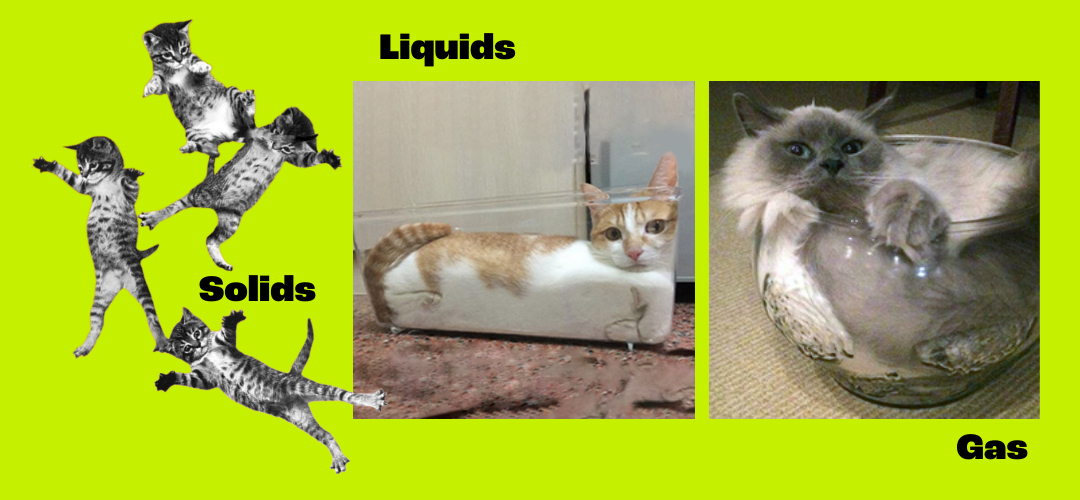Solids, liquids, and gases are different forms of matter. They are called phases or states.
Many substances can be solids, liquids or gases depending on the temperature and pressure they are at. For example, water can take the form of ice, liquid water, or steam. As you heat ice, it will transition between the phases.
Can you think of other substances that can be in different phases? Materials such as wood don’t melt (change from a solid to liquid) because they burn first. There are some things that will change straight from a solid to a gas - missing the liquid phase completely (1)(2)!
One way to define the different phases is like this:
- Solids - the state when matter keeps a fixed volume and shape.
- Liquids - liquids keep a fixed volume but adapt to the shape of the container.
- Gases - they expand to occupy any available volume (3).
Particle model of matter

Scientists explain the different phases using the particle model of matter. We know substances are made up of atoms and molecules and you can imagine them as little balls moving around (4).
Solids are when the balls have the least energy, so they stay fixed in a regular pattern. The particles only move by vibrating around this position; they vibrate faster when heated. Sometimes they will form interesting structures like snowflakes. The structure of solids is very important for their properties. For example, diamond’s structure means it is incredibly strong compared to graphite (pencil lead), which is made up of the same thing - carbon (5)!
In liquids, the particles have more energy so move around but not enough energy to separate very far. Therefore liquids will flow into the bottom of containers. The particles are arranged randomly so don’t have a particular structure like in solids.
The particles in gases have the most energy, so move independently of each other. They whizz around quickly, bouncing off other particles and the walls of a container. This is why gases will expand to fill a container.
Water in space

It isn’t only temperature that affects the properties of materials - pressure does too! When water is in a vacuum like in space, even though the temperature is very low - so low that in Earth’s atmosphere it would be ice - it will boil and turn to steam because the pressure is so low!
But then, as it is so cold and has lost energy from boiling it freezes! A less extreme example of this is mountaineers at high altitudes notice that their water will boil at much lower temperatures than when at sea level (6).
When water is at a standard pressure and temperature but not under the effects of gravity (like on the International Space Station), the forces pull the molecules together to form a floating sphere of water. This happens because gravity is not pulling it down so it forms a shape with the lowest surface area (7).
Stuff that doesn’t fit

Some substances don’t seem to properly fit into one category of phase. If you mix water and cornflour together, you will find that it forms something called a non-Newtonian fluid. This just means that it doesn’t behave like most other fluids. Sometimes it will flow just like a liquid, but if enough force is exerted it will act like a solid, even cracking (8)(4)!
If you use the first definition of the phases based on how they fill a container, it can be argued that cats are sometimes solids, liquids, and gases! If you have a pet cat you may have noticed that they seem to fill the bottom of a container, or if they’re very furry the entire container. Just like liquids and gases!
But when they are just walking around as normal they keep the same shape like a solid does. We all know that cats aren't really liquids, but this does show that scientific definitions aren’t always perfect, and we have to be careful about the contexts we use them in. Cats just sometimes act like liquids (3)!
by Ella Thomas.
References
- “Why Doesn't Wood Melt.” Today I Found Out, 1 August 2013, https://www.todayifoundout.com/index.php/2013/08/why-doesnt-wood-melt/. Accessed 29 June 2022.
- “Sublimation (phase transition).” Wikipedia, https://en.wikipedia.org/wiki/Sublimation_(phase_transition). Accessed 29 June 2022.
- Fardin, M. A. “On the rheology of cats.” Rheology Bulletin, vol. 83, no. 2, 2014, 16-17, 30, https://www.watsu-paris.fr/app/download/5819802223/On+the+rheology+of+cats+-+Rheology+Bulletin+-+juillet+2014.pdf.
- BBC. “Solids, liquids and gases.” BBC, https://www.bbc.co.uk/bitesize/topics/z9r4jxs/articles/zqpv7p3. Accessed 28 June 2022.
- BBC. “Diamond and graphite - Giant covalent molecules - AQA - GCSE Chemistry (Single Science) Revision - AQA.” BBC, https://www.bbc.co.uk/bitesize/guides/z9twsrd/revision/2. Accessed 29 June 2022.
- Siegel, Ethan. “Water in Space: Does it Freeze or Boil?” Forbes, 2016, https://www.forbes.com/sites/startswithabang/2016/12/23/water-in-space-does-it-freeze-or-boil/?sh=7deb45f75f91. Accessed 28 June 2022.
- Water Science School. “Water in Space: How Does Water Behave in Outer Space? | US Geological Survey.” USGS.gov, 23 May 2019, https://www.usgs.gov/special-topics/water-science-school/science/water-space-how-does-water-behave-outer-space. Accessed 28 June 2022.
- “Non-Newtonian fluids — Science Learning Hub.” Science Learning Hub, 12 April 2010, https://www.sciencelearn.org.nz/resources/1502-non-newtonian-fluids. Accessed 29 June 2022.

